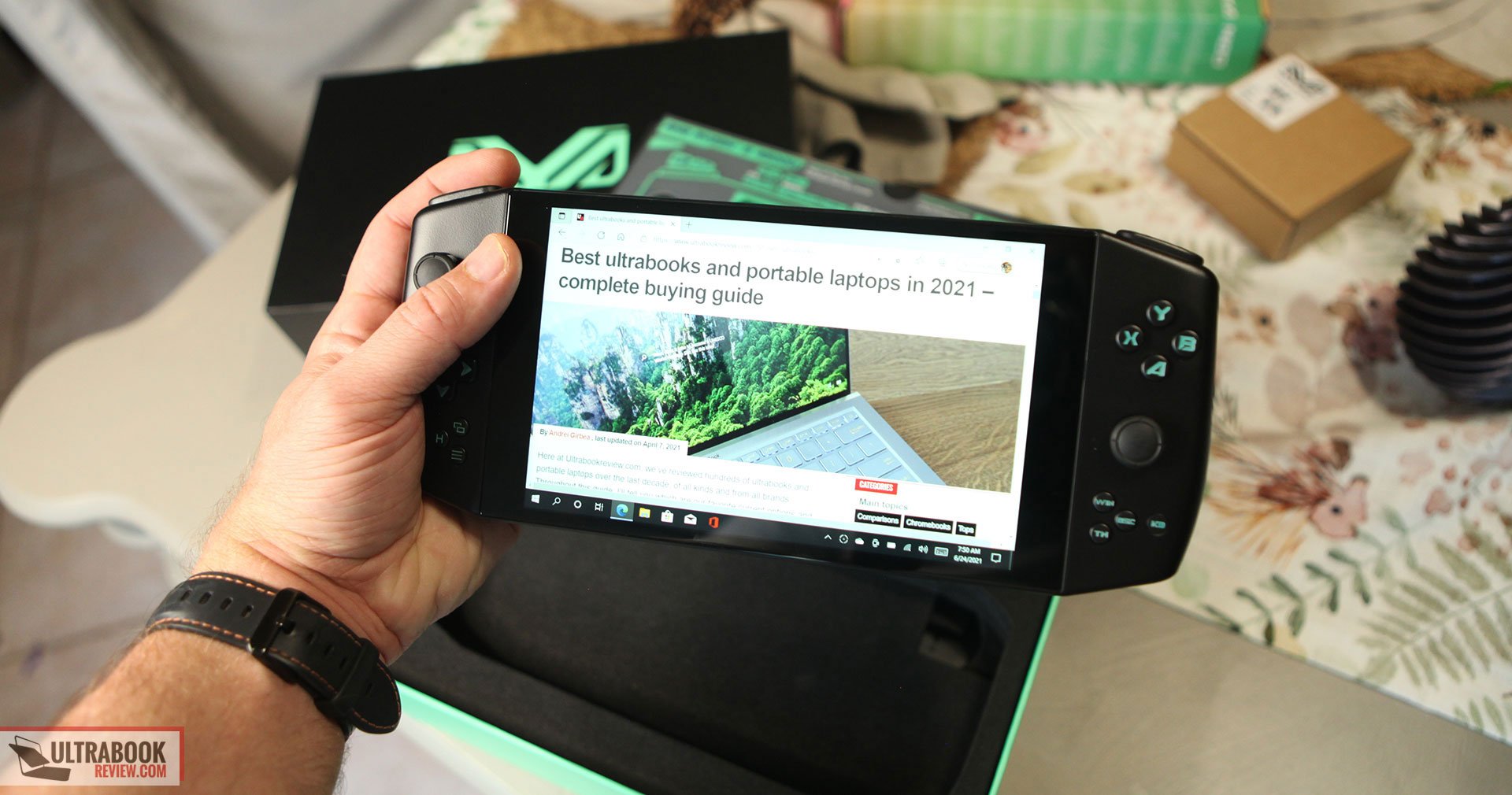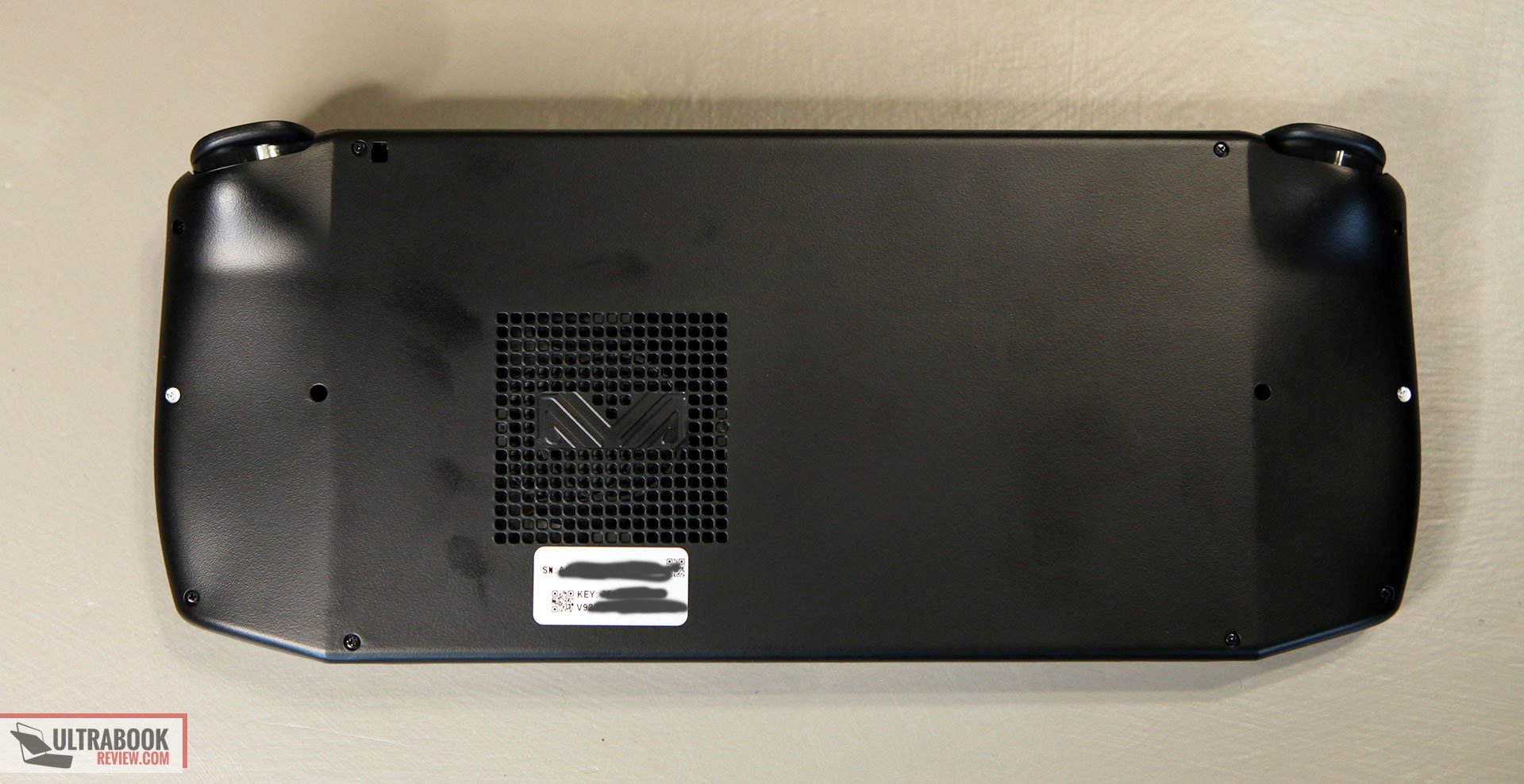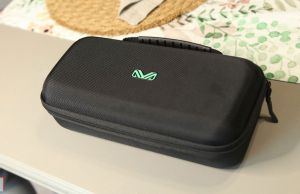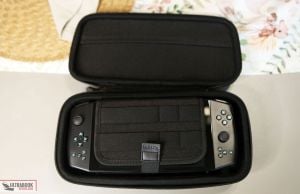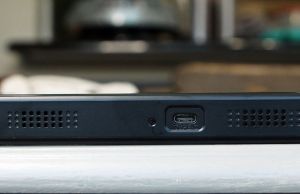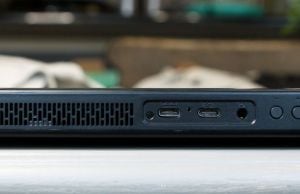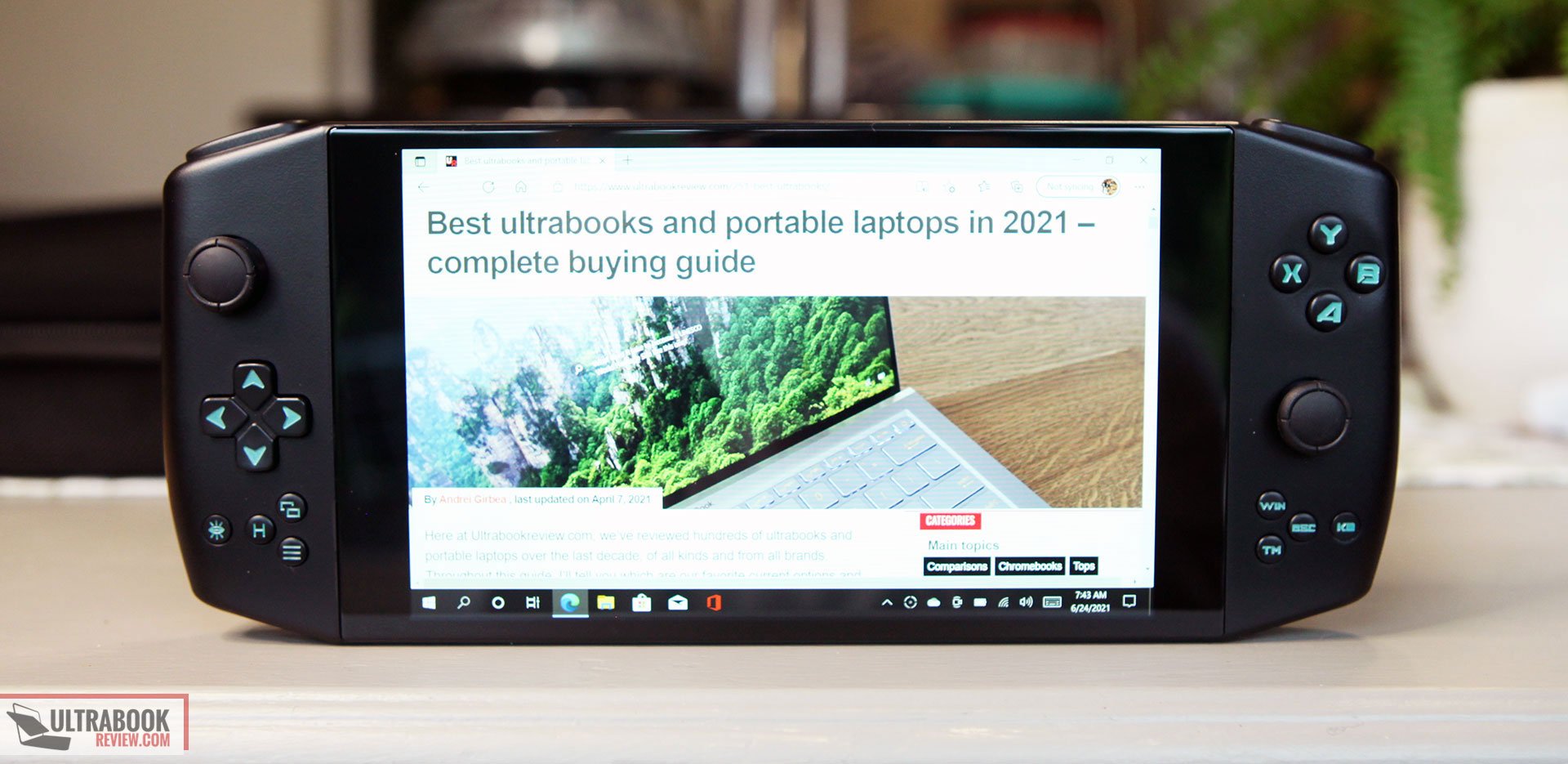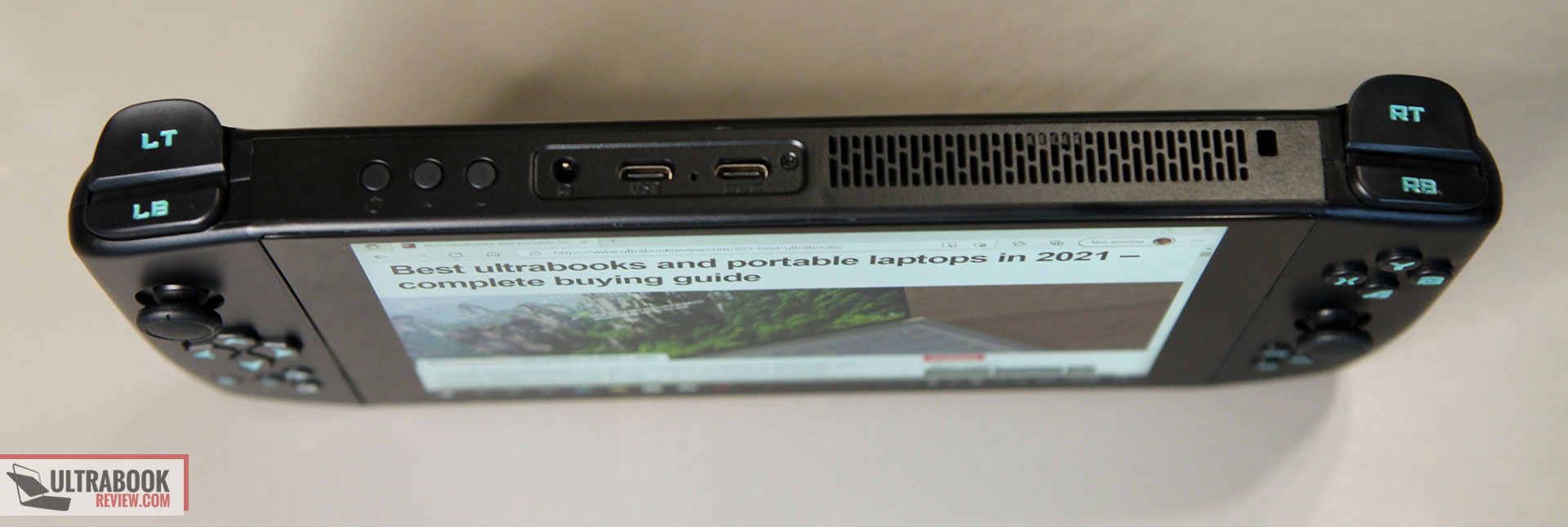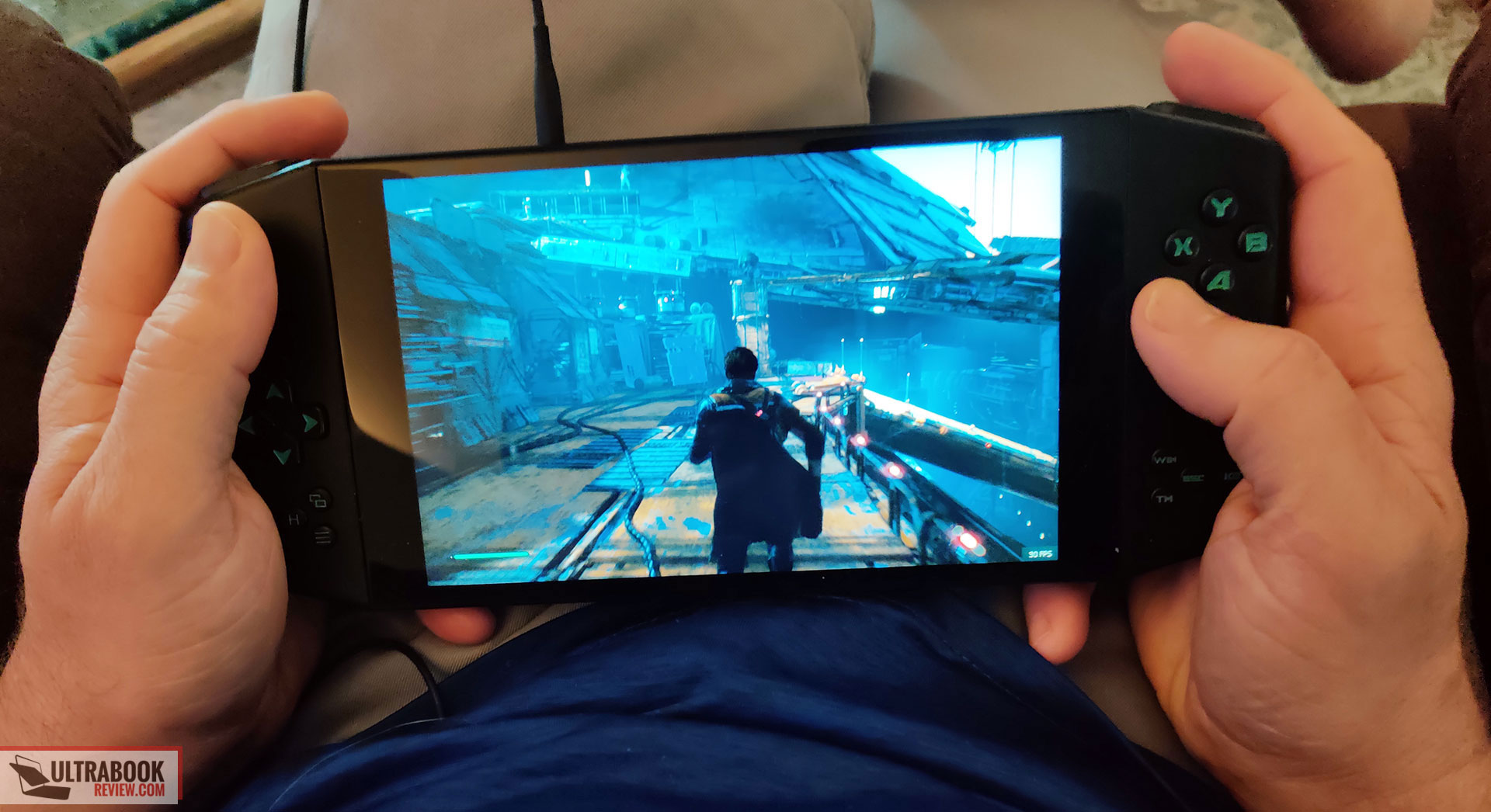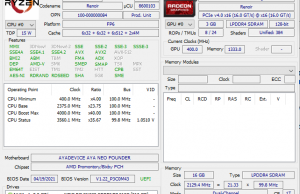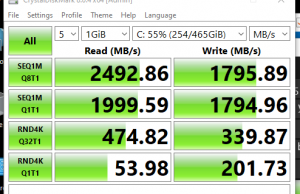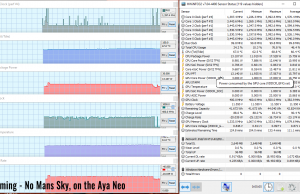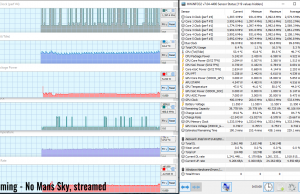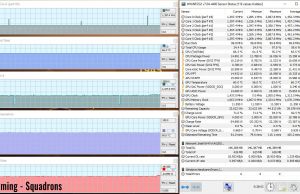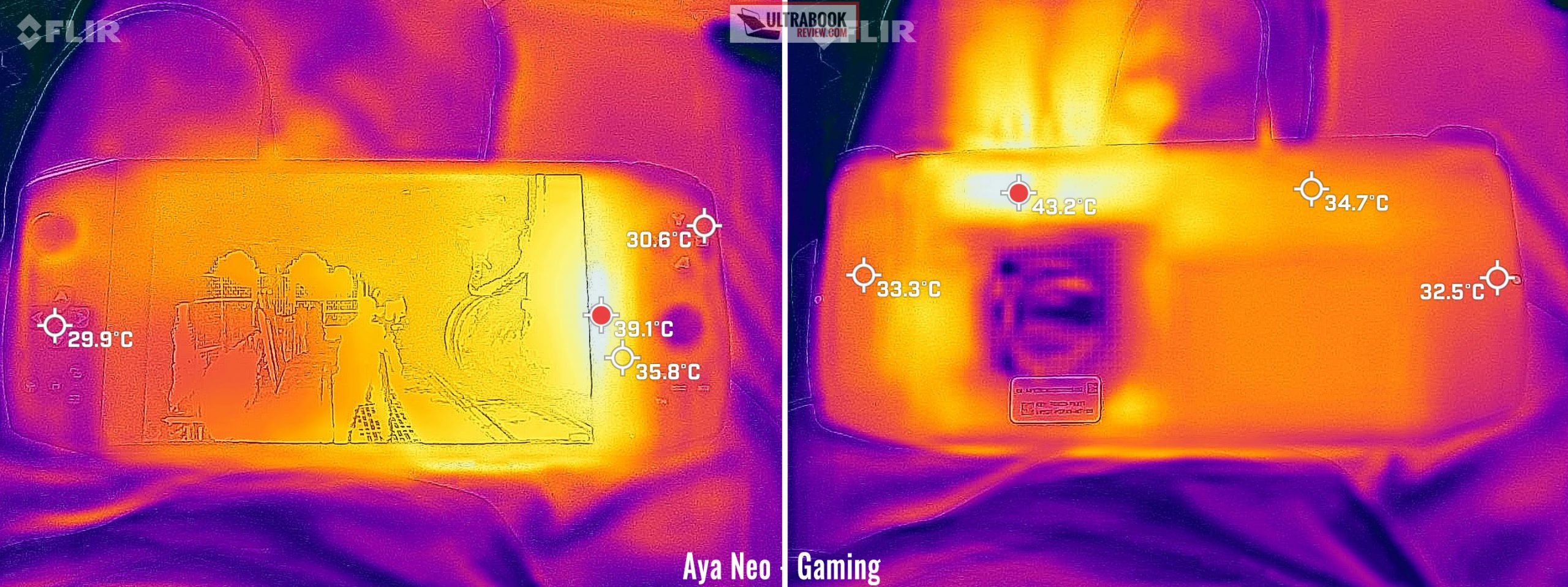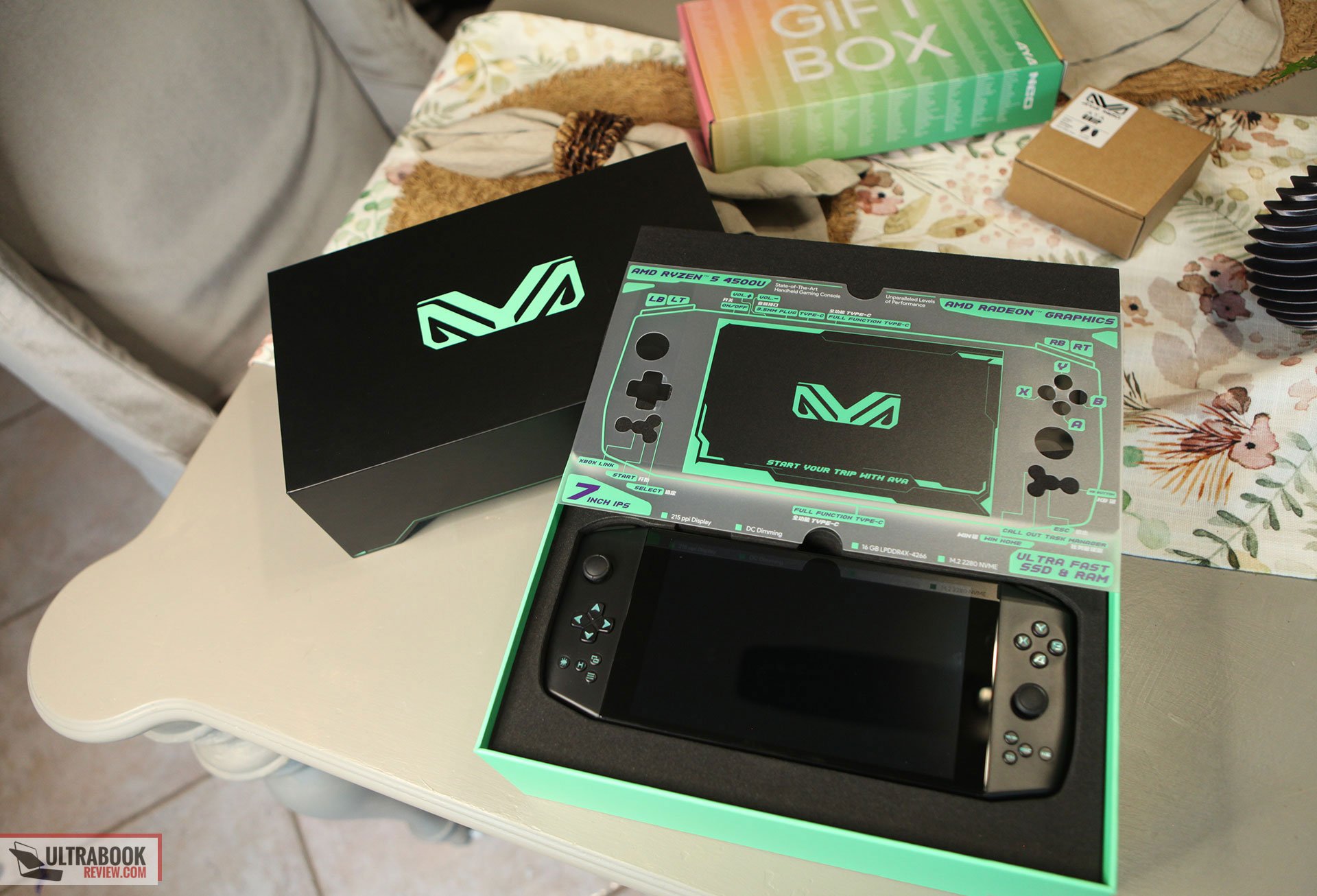I certainly consider myself an early adopter when it comes to tech. I’m frequently running beta programs and crowdfunding new ideas. That’s why when I saw the world’s first Ryzen handheld, the Aya Neo, I didn’t hesitate to put in a bid and get one.
Luckily, I was one of the first 42 backers, so I got the early bird price of $700. That also put me in the first batch of products. The price seems steep considering the specs, but there just aren’t that many players making devices like this. Until now that is…
I’ll admit, I’ve been kind of dragging my feet on this review. First off, it’s tough to write a full review on this device since it’s not exactly finished yet. I do have a device in hand, but there are some key fixes Aya needs to make before they call the product finalized. And I should be getting those updates sometime in September.
I also hesitated due to lack of interest. Back in 2017 I wrote a review on the GPD Win, which is a handheld PC that really caught my attention. It’s an incredibly niche device though and judging by the feedback I saw in the comments, it was a very small niche group. I even got a GPD Win 2 and passed on writing up something about it (good device btw).
But after seeing the hype train take off last week about the Steam Deck – my goodness where did all this interest come from? Piles of people jumped on preorders (myself included) and I’m just not sure how it was so well received from just an advertisement. I’m guessing only because it’s Valve and perhaps the entry price.
But seeing how most people won’t see the Steam Deck until at least Q2 of 2022 (the current preorder deadline), I think I should at least put some info of what the competition is offering with the Aya Neo. If you think handheld gaming is your thing, perhaps this device would fill your void while you wait for the Steam Deck reviews.
Like I said though, this device isn’t finished yet. My review is going to be based on my month’s experience with the “first batch” of these handhelds, of which only 500 were made. It’s different from the previous reviews too (with the clear casing), as those units were “Founders edition” and were only distributed to key people as prototypes.
My review will be on what is closer to the released product, but still has a few bugs that need to be worked out. And the good news is I’ll also be getting those fixes on my current unit, so I’ll be sure to update this when that happens. So let’s dive in.
Specs as reviewed – Aya Neo
| Aya Neo | |
| Screen | 7 inch, 1280×800 px (16:10), 215ppi, IPS, 60 Hz, touch |
| Processor | AMD Ryzen 5 4500U, 6C/6T, 2.3 Ghz base, up to 4.0 GHz Boost |
| Video | AMD RX Vega 6 |
| Memory | 16 GB LPDDR4X-4266Mhz |
| Storage | 512GB or 1TB M.2 SSD |
| Connectivity | Intel AX200 Wifi 6 and Bluetooth 5.2 |
| Ports | 2x USB-C 3.2 gen2 with PD charging support and DP 1.4, 1x USB-C data only, headphone jack |
| Battery | 47 Wh, 65W PD charger |
| Size | 255 mm or 10.04” (w) x 106 mm or 4.17” (d) x 20 mm or .79” (h) |
| Weight | .65 kg (1.43 lbs) |
| Extras | Dpad with individual buttons, ABXY, L1&2, R1&2, dual joysticks with clickable L3/R3, 8 additional media buttons, rumble feedback, stereo speakers, gyro, accelerometer |
Design and construction
The Aya Neo is completely encased in plastic. It’s .79” thick, which might be off-putting to some. But to me, this is ok – it is meant to be held in our hands as a controller after all.
The plastic shell is pretty sturdy all around the device. And it looks clean. One thing I’m usually seeing with startups is the lack of attention to detail with their first batches – typically sink marks and parting line flash on the molded plastic parts. This is not the case with the Aya Neo.
I didn’t notice any creaking or anything in the plastic. There was a minor bit of flex in the plastic vent on the top, so be careful not to push too hard there. It’s not exactly a place you grip the device though.
The right and left sides of the device are meant for holding the device so there aren’t any ports or anything – just buttons. It feels natural to hold too. 1.43 lbs is not the lightest device, but it’s not too bad once you get used to it. It’s not like my hands got tired or anything.
For a better feel, Aya also sells grips that you can attach to the device. I opted to wait before attaching these, as they are sending me a replacement shell at some point. I also like the way this rests on a table right now and I think grips would only make that worse.
If you’re thinking of keeping this thing in your pocket like you do the Nintendo Switch, think again. This is way too big, unless you have really really loose pockets. It’s even more impossible if you install those grips.
Aya also ships the Neo in a nice protective case that snugs the device in place while inside and should provide adequate protection in your backpack.
As for IO, there’s a couple of USB-C ports on the top and another one on the bottom. The top two are reserved for data and the bottom is for data and charging. That bottom port hooks into a dock that is sold separately, but also supports Displayport, if you wanted to output to a screen.
There’s not much else in terms of IO. Just a headphone jack on the top and that’s it. The rest of the space on the top is reserved for fan exhaust. And the bottom has cutouts for the speakers.
It’s a pretty cool design if you ask me. It’s easy to hold, put down and stand up. It’s light enough and feels sturdy. I feel like it’ll last a long time. Just don’t drop it!
So many Control and Buttons
Being a handheld gaming device, of course, you expect there to be a lot of buttons. And there are! In fact, there’s just the right amount, in my own opinion.
On the left-hand side you get an analog joystick at the top, a D-pad underneath, and four buttons: start, select, Xbox link and an eyeball button which apparently controls RGB lighting that doesn’t exist. Huh?
On the right, we have the standard ABXY buttons on the top. Underneath is another analog joystick. Both of these joysticks are clickable for R3 and L3 by the way. And at the bottom is another 4 buttons: Windows key, Esc, Task Manager and a dedicated keyboard button.
That keyboard button will call up a software keyboard to go on top of whatever you are doing, just in case you need to hit a particular key for any reason. Otherwise, you’re stuck without attaching a USB keyboard or something. It’s small but it works good enough.
On the shoulders, there are two buttons on each corner, similar to what you’d see on an Xbox controller. Finally, on the top edge, you have a power button and volume buttons. These buttons are extremely low profile too. I don’t mind this for the power button, but I’d have preferred my volume buttons to be a bit taller. No biggie – the speakers are so quiet that my volume is almost always at 100%. More on that soon.
Now let’s talk about how well this all works. For the most part, I think the controls worked fine. The joysticks are pretty much identical to those that I’ve seen on other handhelds, so there were no surprises. For most games they work great, but for others they are a little too sensitive. This can all be adjusted in game settings though, so it’s just something you’ll have to tinker with to optimize.
The buttons offer pretty decent feedback when pressed. The bottom buttons are great, but I’d like to see a tiny bit more travel on the ABXY buttons. At least they aren’t mushy. I was able to use all the buttons just fine, so left as it is I think it’s fine.
The shoulder buttons are also pretty decent. Again, I like these better than my Win 2 because they feel more like buttons. On the GPD Win 2, they are more like mouse clicks, which makes sense because they were actually used as left and right mouse buttons. These buttons feel much more natural.
I do have some criticism with the top buttons, but it’s all getting fixed in the next batch. Like I said, my unit has some very low profile volume buttons and a power button. They all feel identical too, so sometimes I hit the power button instead of volume down. But in the next batch, the volume buttons will be raised more so you can tell the difference. Good thing.
The paint on the buttons is also a little…low quality. Some of the buttons I have a touch time reading the letters, like KB. And I didn’t have a clue what to make of that eyeball key. But all this is getting upgraded in the next batch as well.
The other buttons getting upgraded are the shoulder buttons. Now I thought these were fine, but Aya is changing them out to be analog instead of digital. What this means is racing games will be able to take advantage of this, making them more playable. I’m open to this, but we’ll see how well they perform when I get them.
In the end, the buttons are all acceptable for now. I like them better than what I have on the GPD Win 2. And as a controller, I didn’t struggle to use it at all really. Once I got my settings dialed in, it performed very well and felt natural. I’m looking forward to seeing how the upgraded buttons compare.
The last thing to mention is the rumble feedback. It’s ok, but I wish there was a way to control the intensity. For some games like Jedi Fallen Order, it’s perfect and feels natural. But for Horizon Zero Dawn, I found it extremely distracting to have on. If it were half the intensity in that game, it would have been fine.
Screen
The screen on this unit is 7 inches with a maximum resolution of 1280×800 px and a refresh rate of 60Hz. It’s an IPS screen, with some of the best viewing angles I’ve ever seen – similar to what you’d see on a high end smartphone. It’s a good panel, but it’s far from perfect.
Fact is, the backlight bleeding on my panel is some of the worst I’ve ever seen. Now keep in mind that I have the first batch of units available – so yeah, I got some of the bugs. But it’s there for my unit and it’s completely unacceptable in my opinion. Not only can I see it on every black screen, it also shows up through colors on some games.
The good news is the owner of Aya said the future batches should not have this issue. He also offered to repair the backlight bleed on mine and others units from the first batch. So that’s responsible for them at least.
The other beef I have with this panel is the color accuracy. The default profile was very warm, so my first instinct was to calibrate the panel. But it ended up being very difficult, as no matter what I tried, some of the colors would come out strange looking. I reverted back to the default profile and just lived with it.
The resolution is a little low, but I don’t hold that against them. Really, if this is expected to perform well for gaming, the resolution needs to be below 1080p for the iGPU to even have a chance to run games above 30fps.
One nice thing about the panel is it’s touch-enabled. It’s basically a tablet screen at this point and works all the same. Multi-touch gestures and touch accuracy were both very good.
I did get some measurements on my X-rite i1 Display Pro sensor and here’s what I got:
- Panel HardwareID: unknown
- Coverage: 95.3% sRGB, 65.7% AdobeRGB, 67.5% DCI-P3;
- Max brightness in the middle of the screen: 284 cd/m2 on power;
- Contrast at max brightness: 737:1
- Native white point: 6400 K;
- Black on max brightness: 0.4 cd/m2.
So, not the greatest contrast ratio or maximum brightness either. But to be honest, the brightness was just fine to me. Just don’t expect to use it outside against sunlight is all. Especially considering the screen is glossy and glass – the glare would be terrible.
In general, I’m not all that thrilled with this panel. It’s good enough, but certainly has room for improvement. Even if I get the backlight bleed improved, I still think I’ll be a little disappointed with the color inaccuracy a little bit. Perhaps I’ll figure something out though.
Again, the owner of Aya has expressed dissatisfaction with this panel so far, so perhaps he’ll be able to source another one in the future. I also know that in my upgrade kit I’ll be receiving a new screen, so I’ll keep my fingers crossed.
Hardware and performance
The Aya Neo comes with a 3rd Gen AMD Ryzen 5 4500U. This is a 6 core processor capable of 2.3Ghz per core and 4.0Ghz boost. I wouldn’t count on hitting that 4.0Ghz, though. Even after a couple of seconds with a Cinebench run, the frequency quickly levels off around 3.0Ghz.
There’s no dedicated GPU in this unit, so you have to rely on the integrated Radeon RX Vega 6 graphics. This isn’t the best option for gaming, but at least we’re only driving an 800p screen here.
There’s 16GB of LPDDR4X-4266 memory in my unit. I’m pretty positive this is soldered onto the mainboard, so no chance of upgrading it. Honestly though, there’s little to no reason to have more than 16GB of RAM for this level of gaming. Even with my most detailed spot in Valheim, I only managed to hit 7GB of used RAM.
There’s a 512GB M.2 SSD in my unit. They offer bigger drives, but I honestly don’t see any reason why you’d want one. More on that soon. The drive is plenty fast enough though. I took some CrystalDisk readings and got the typical NVMe readings for a stock SSD. That’s pretty much all you need for this level of gaming though.
I took some synthetic benchmarks with the default settings. Here’s what I got:
- 3DMark 13 – Fire Strike: 2966 (Graphics – 3249, Physics – 10927);
- 3DMark 13 – Time Spy: 1118 (Graphics – 994, CPU – 3868);
- Uniengine Superposition – 1080p Medium: 1869;
- GeekBench 5: Single-Core: 1476, Multi-core: 7695;
- CineBench R15: OpenGL 65.42 fps, CPU 756 cb, CPU Single Core 169 cb;
- CineBench R23: CPU 4948 pts, CPU Single Core 1132 pts;
These results are actually ok. The 3DMark scores are about what I’d expect for integrated graphics. The CPU scores are good too. Keep in mind this is a hexacore CPU in a cramped space.
The results show that this is an appropriate CPU choice for this device too. The multicore performance is good enough for any game that might need 6 cores(probably not many). But the single-core results are pretty much just as high as the R7 5700U.
Thing is, the CPU levels out at 16W during a Cinebench run, so it’s being held back a little bit anyways. We’re running on battery here, so you want a balance between performance and battery draw, and this is what Aya chose.
I’ve run a number of games and set the performance to where I called it “playable”. See below for my results:
| HD | |
| Star Wars Squadrons(High settings) | 55 fps avg, 40 fps low |
| No Man’s Sky(Standard Settings) | 43 fps avg, 36 fps low |
| Doom Eternal (Medium) | 50 fps avg, 40 fps low |
| Valheim (low) | 25 fps avg, 21 fps low |
| Dragon Quest XI S | 40 fps avg, 36 fps low |
| Jedi Fallen Order | 36 fps, 25 fps low |
| Power Wash Simulator | 58 fps avg, 50 fps low |
I’m surprised that some of the more modern games were as playable as they were. Valheim, for example, was still decent enough to play at 25fps. And Jedi Fallen Order was definitely playable. Most importantly, Power Wash Simulator runs close to 60fps. This is the perfect device to curb your pressure washing addiction. :)
I don’t think I’m even going to try some games though. Cyberpunk for example doesn’t play well with a dGPU, so I can’t imagine playing without one. Horizon Zero Dawn was also kind of tough to play on the iGPU.
But for more demanding titles, you can still Steam stream. That is, assuming you have a PC that can handle them on the same network. I was steam streaming Horizon Zero Dawn from my desktop for a good hour, with zero problems. The refresh rate stuck at 60fps pretty much the entire time. Other titles should perform just as well assuming you have good Wifi.
But just because you can play some of these titles, it doesn’t mean you should. Horizon Zero Dawn, for example, wasn’t that fun to me. At 800p on a 7” screen, the level of detail was far from good for that game. Aiming was extremely difficult sometimes too. But perhaps for a game like that, I would just set the difficulty to casual and just enjoy it instead of being ultra stressed.
There’s also the struggle of finding games that are even playable without a mouse and keyboard. This is going to be the same struggle for those interested in the Steam Deck. Fact is, PC games are usually built for PC users – who own a mouse and keyboard.
Mulling through my Steam library, I’d say half of the titles were even playable on a controller and a lot of my library is a bunch of legacy console ports. Many of the others would require some remapping effort too. Your results will certainly differ depending on what types of games you play.
The only reason I’m mentioning it is, while these devices may seem really cool, you really should look at your library and decide what you’ll actually play on a device like this. And if it’s worth spending hundreds of dollars for.
Nevertheless, I’m pretty impressed with the performance of this device. It plays many recent titles fairly well. And it also plays the rest perfectly through Steam streaming. I’m looking forward to trying out more things in the future with it. And for me, it’s easily my GPD Win 2 replacement – this is way better.
Noise, Heat, Connectivity, speakers, and others
The Aya Neo is pretty limited on real estate, so keeping that CPU cool can be a little challenging. But the solution they have does a pretty good job in my opinion.
The solution is simple. A very large fan on top of the thermal module, on top of the CPU. Air gets drawn into the back of the unit and blows across the thermal module, out through a small radiator on the top edge.
But at the end of the day, it keeps the CPU plenty cool enough to operate properly. The lowered sustained TDP also helps keep temps at a reasonable level.
Fan noise was pretty good actually. When playing No Man’s Sky, the fan only reached 35dB at ear level. It really helped that the fan was facing away from me.
The most annoying thing about the fan is the oscillation when the CPU spikes. While gaming, the TDP levels out because the CPU can’t Boost for that long. But for short tasks or downloading, the CPU tends to spike, making CPU temps hit the 80s once in a while. In this case, the fan will cycle on and off to compensate, to the point where it gets really annoying. The only way to fix it would be to limit the CPU somehow. Dropping Boost might do the trick, but I haven’t tested that yet. It’s minor, so I’m leaving it for now.
I took some thermals on the front and back, even though I didn’t really see the need to. The device doesn’t get hot in the spots you will be touching the most. It stayed very cool, even during longer sessions.
The Wifi module is fine. It’s an Intel AX200 Wifi 6 module with some pretty decent coverage. My typical router test from 30 feet away resulted in download speeds of 420Mpbs. I didn’t experience any drops in connection or anything either.
The speakers are probably one of the most underwhelming features of this device. The sound is just very low for starters. Cranked all the way up, I’m only able to reach 65dB, but that’s also only the highs. The mids are much less audible and the bass is almost nonexistent.
It kind of takes away from the experience, especially if you’re battling background noise in the same area. You’re more than likely just going to use headphones if you want to immerse yourself in the game more. Unless of course, you’re playing an older title where the music isn’t as good, then maybe you want the volume low.
This is another area that Aya promises to fix in the next batch. My “upgrade kit” is supposed to be coming with a new pair of isolated speakers, which should sound much better. I’m very much looking forward to that.
If you’re looking for a webcam on this device, keep looking. There really isn’t much purpose for one though. This isn’t meant to replace a laptop or even your phone
Battery life
The Aya Neo has a 47 Whr battery. It’s small, yes, but this is a small device and one that they need to worry about being overly heavy, so that battery is probably about as big as you’d want it.
Rather than my usual battery tests that I do with laptops, I just took a couple in some gaming scenarios. Here were my results:
- 23.2 W (~2 h 2 min of use)– No Man’s Sky, screen at 100%, Wi-Fi ON;
- 11.6 W (~4 h 3 min of use)– No Man’s Sky, Steam Streaming, screen 10 100%, Wi-Fi ON.
I can’t really judge if these are good or bad. There’s really not much competition to compare it to, so it is what it is. Honestly, though, this is better than what I was expecting. And I could easily just attach a UCB-C cord into the bottom and charge while playing, if I wanted to.
About Aya and my Indiegogo experience
Overall, I’d say the whole experience was pretty great. Between Kickstarter and Indiegogo, I’ve probably done a couple dozen of these things and this was one of my favorites.
The CEO, Arthur Zhang, is probably one of the most passionate and thorough campaigners I’ve ever dealt with. He gave constant updates throughout the process, was very transparent, and has a good presence on Discord to answer questions. As a backer, there’s not much more I could have asked for.
What really blew me away was the package I received. I was honestly just expecting this thing to come in a plain box like my GPD Win did when I funded it. Instead, I got what you see here in the picture – very nice-looking packaging that gets you excited about what you bought.
And some icing on the cake – I also got a gift box full of goodies, such as a convertible USB cord, lanyard, phone holder, screen protector, stickers, USB port pugs, and more. And the gift box even had all the backers’ names printed on it. What a heck of a first impression!
Now I’ll admit, my first impression died a little after seeing the backlight bleed and speakers. Not the end of the world, mainly because I expect this from being an early backer. But I was blown away when the CEO said they were sending us an upgrade kit to make things right. That’s pretty awesome if you ask me.
After all these new handhelds finally launch, I hope Aya has enough of a following to stick around. It’s not often I see stuff like this, so I hope they do well enough to keep it up. I can’t wait to see how it all turns out.
Price and availability
The model I purchased was through Indiegogo, and I was lucky enough to get one for $698. The retail version is supposed to be $869, but from my experience with these campaigns, you’ll usually find them on Amazon for cheaper if you’re patient enough.
If you want it now though, you can look on ayaneo.com and place an order. The 512GB version is $925 and the 1TB version is $1015. Steep.
It says on their website that shipping starts in August. “Starting” maybe but I wouldn’s expect an order placed now to ship then. From what I’ve been seeing in the Indiegogo updates, production is frozen until they update all the components. And I can’t imagine the amount of backorders they have now.
Final thoughts
Bugs aside, this is still a pretty cool device. I think so at least. But I’m also a tech geek who likes trying out new stuff.
Like I said at the very beginning – it’s a device for a very niche crowd. And it’s also very expensive. So you’ll want to do your homework before investing in something like this.
If I had any advice to give someone considering a device like this (or the Steam Deck), I would say to consider the following: First, scroll down your Steam library and see how many games you have that are even capable of being played without a keyboard and mouse. You’d be surprised how many you remove (for me it was half).
You should be able to filter that list even more, when you consider how playable a game would be on a 7” screen at 800p. Don’t forget that 0-3-year-old titles will probably have to be played on the lowest graphics settings as well. Tiny text and grainy images are very hard to see at that size.
In the end, then ask yourself, is it worth spending $530-1000 to play those remaining games on a handheld on your couch for just a couple of hours at a time. Or should you just get a laptop and an Xbox controller instead?
Steam Deck vs Aya Neo vs GPD Win 3
If you’re still interested, your next dilemma may be Steam Deck vs Aya Neo vs GPD Win 3. For the sake of simplicity, let’s consider the GPD Win 3 and Aya Neo equal for now, as they are very similar devices at similar costs.
The Steam Deck starts at $400, but let’s go apples to apples and look at the faster 512GB SSD model, which is $649. That’s $300 cheaper than the Aya Neo, so it’s very tempting I’m sure. It’s also made by Valve, which is a reputable company. But Steam Machines also flopped, so that might be a thought too.
The cons to the Steam Deck are pretty obvious to me though. First, it’s Linux-based and Steam library only. Right out of the box, you’ll only be able to play the games that Valve decides to support. Yes, you can install Windows, but that’s going to cost you a Windows license. And there’s no telling how well it will be supported by Valve.
The other thing I’m skeptical about with the Steam Deck is the controller setup. Looking at the button and joystick layout makes me wonder how comfortable it is to use the controls. I can’t make any solid judgment because I haven’t tried it yet, but it reminds me of the controls on the GPD Win 2 – only backwards. And I know I like the Aya Neo controls a LOT better than that device.
The Aya Neo’s controls feel more like an Xbox controller to me. I’m able to use the right joystick with the inner joint of my thumb and then quickly switch to mash buttons with the tip of my thumb. I don’t think that would work with the Steam Deck.
The last thing to consider is availability. Preorders for the Steam Deck are out to Q2 2022, which is just plain crazy. And if you believe Aya, the Neo should be shipping next month. So your choices are a couple of months or wait an entire year and save a couple of hundred dollars.
So yeah, I’m not really on the hype train for the Steam Deck. Not yet at least. I did preorder one for review though – so I should have mine sometime in Q1 2022 unless Valve sends us a review unit.
But as for the Aya Neo, I can see some hope for the new startup. The device does have its bugs, but they are promising to fix them and are even going back and fixing their original customers. That’s a really good start – I just hope they have the funds to stay in business. And that the fixes actually fix the problems I saw.
But even if I left the device as is, I still think it’s a pretty good device. And I’ll definitely keep using it until it’s time to upgrade. Once I do upgrade it, though, I’ll be sure to report back on how it goes and if things improve.
I’m more interested to see what anyone else thinks about this though. Is this a device you’re interested in, or do you think it’s too expensive? If you’re into it, what do you plan on using it for? Shoot me a comment below and let me know. Same, if you have any questions on the Neo – I’d be happy to answer them.
The post Aya Neo review – AMD Ryzen handheld gaming device appeared first on UltrabookReview.com

